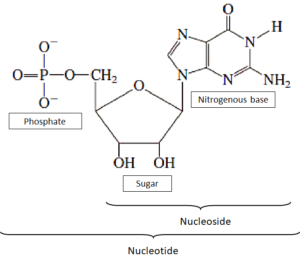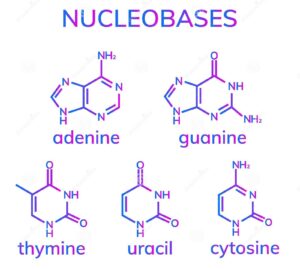NUCLEOSIDES AND NUCLEOTIDES
Overview
Nucleosides and nucleotides are the fourth and final major group of biochemical molecules. The unique structures and interactions of these molecules serve as the building blocks of RNA and DNA molecules and allow fundamental processes of gene replication and protein synthesis to occur.
These molecules can be divided into two major families-
- Purines- include adenosine and guanine,
- Pyrimidine- includes cytosine, thymidine, and uracil.
Nucleosides have a nitrogenous base and a five-carbon carbohydrate group, usually a ribose molecule.
Nucleosides= Base + Sugar
Nucleotides are simply a nucleoside plus one or more phosphate groups attached. The resulting molecule is found in ribonucleic acid (RNA).
Nucleotides= Base + Sugar + Phosphate
If one hydroxyl (OH) group has been removed from the ribose, the deoxy versions of the nucleoside and nucleotide form the building blocks of deoxyribonucleic acid or (DNA).

Role & Medical Relevance
- Nucleosides and Nucleotides are closely involved in the preservation and transmission of the genetic information of all living creatures.
- They also play roles in biological energy storage and transmission, signaling, regulation of various aspects of metabolism. They have important role as an antioxidant too.
- Mistakes or deficiencies in their synthesis usually lead to death. Overproduction or decreased elimination of nucleic acid derivates also lead directly to medical conditions.
- Use of several nucleoside analogues takes place in medicine as anticancer agents or antiviral.
Basic Structure
Nucleosides are made of a nitrogenous base, usually either a purine or pyrimidine, and a five-carbon carbohydrate ribose. There are five major nucleoside bases are common in human biology:
- The purines (two-ring structure)- Adenine and Guanine
- The pyrimidines (one-ring structure) – Cytosine, Uracil, and Thymine.
Components of Nucleosides and Nucleotides
Nitrogenous base– The nitrogenous base of a nucleoside or nucleotide (Nitrogen atoms found in its structure hence the name) may be either a purine or a pyrimidine.
Purines, including inosine (I), adenine (A), and guanine (G), are two-ring structures and pyrimidines, including uracil (U), cytosine (C), and thymine (T), have only one ring. Both purine and pyrimidine nitrogenous bases are made, in part, from amino acids.

Differences between Nucleotides and Nucleosides
Parameter Nucleotide Nucleoside Structure It consists of a nitrogenous base, 1-3 phosphate groups, and sugar- deoxyribose and ribose. It consists of a nitrogenous base that has an attachment to sugar in a covalent manner without the phosphate group. Chemical composition Nucleotide consists of a phosphate group, a sugar and a nitrogenous base. It consists of a sugar and a base without the phosphate group. Medical Relevance Dysfunctional Nucleotides lead to the onset of cancer due to the accumulation of damaged DNA. Use of several nucleoside analogues takes place in medicine as anticancer agents or antiviral. Role in Nucleic acid It makes covalent bonds with other nucleotides to result in the formation of nucleic acid strand. It undergoes phosphorylation to result in the formation of nucleotides. Examples Uridine monophosphate, guanosine monophosphate, cytidine monophosphate, adenosine monophosphate, thymidine monophosphate Uridine, guanosine, cytidine, adenosine, thymidine